
A Complete Guide on Cartilage Piercing
Posted on
The trend of piercing has come a long way. Cartilage piercing has always been popular among women.
However, today, even men are opting for cartilage piercing. Yes, cartilage piercing for men is very popular.
More and more men opt for cartilage.piercings. If you also want to get your cartilage pierced, then continue reading this post.
Here, we will discuss everything, including types of cartilage piercings, cartilage piercing bump, concerns, and care for such piercings. So, without any further ado, let’s get started…
What Exactly is Cartilage Piercing?
Cartilage piercing is a practice of getting a decorating hole in any cartilage-filled parts of your body, including nose and ear.
Cartilage is a connective tissue found in numerous parts of the body, which include ear and nose.
These tissues give strength and elasticity to the area where they are found in the body.
Piercing is pretty common and is usually done for making a fashion statement or for cultural or religious significance.
However, it is crucial to be very careful when getting cartilage pierced.
Types of Cartilage Piercings
Cartilage piercing on men can be done on various places along the ear.
Here is a breakdown of the different types of cartilage piercings to help you explore your options. Take a look…
1. Helix Piercing
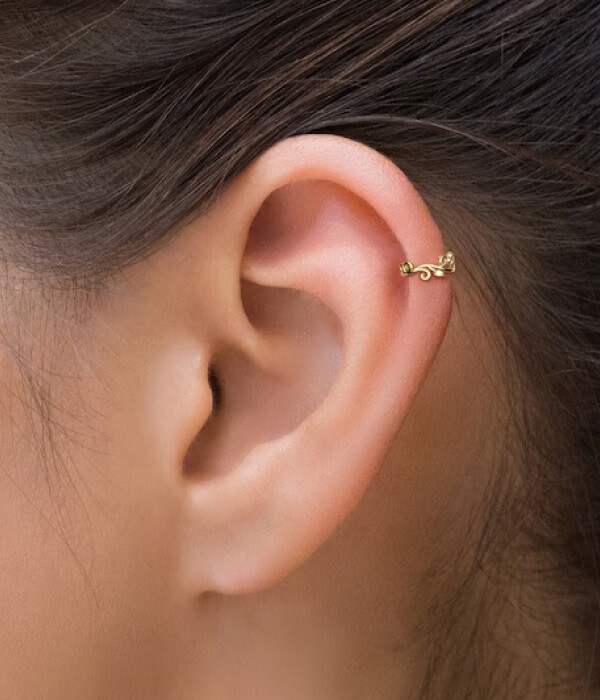
This kind of piercing is pretty common. It is done on the outer upper rim of the ear.
You can choose to get a single piercing on the upper cartilage or multiple piercings along the upper curve.
2. Forward Helix Piercing

Another common cartilage piercing on men and women is forward helix piercing.
It is done on the front side of the ear (near where the helix meets the face).
You can choose to get double or triple piercings.
Also See: 14 Cool Ear Piercing Ideas
3. Industrial Piercing
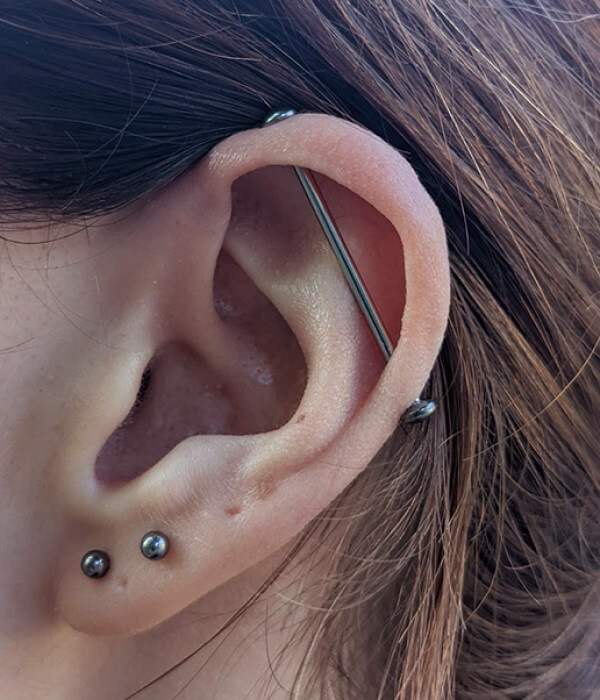
Two piercings connected by a straight barbell, usually running diagonally across the upper ear is called industrial piercing.
Industrial piercing is very popular mens cartilage piercing. Most men prefer this kind of piercing.
4. Daith Piercing
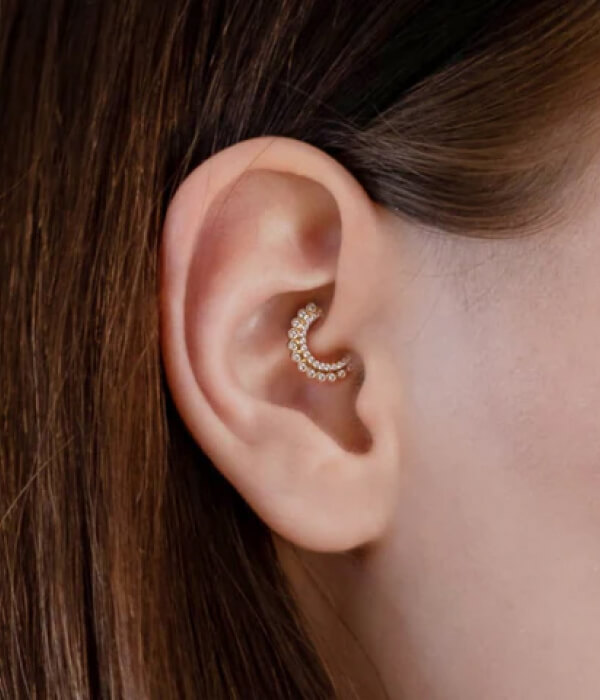
Another popular cartilage piercing ear is daith piercing.
It is done on the innermost fold of the ear, just above the ear canal.
5. Tragus Piercing
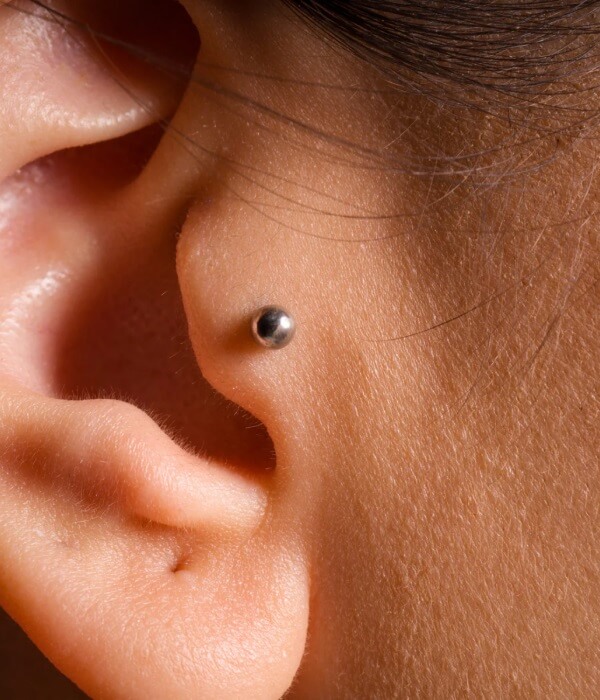
Piercing on the small flap of cartilage in front of the ear canal is known as tragus piercing.
This kind of piercing is not advisable for people who wear hearing aids as it can hinder hearing aids functioning.
6. Anti-Tragus Piercing
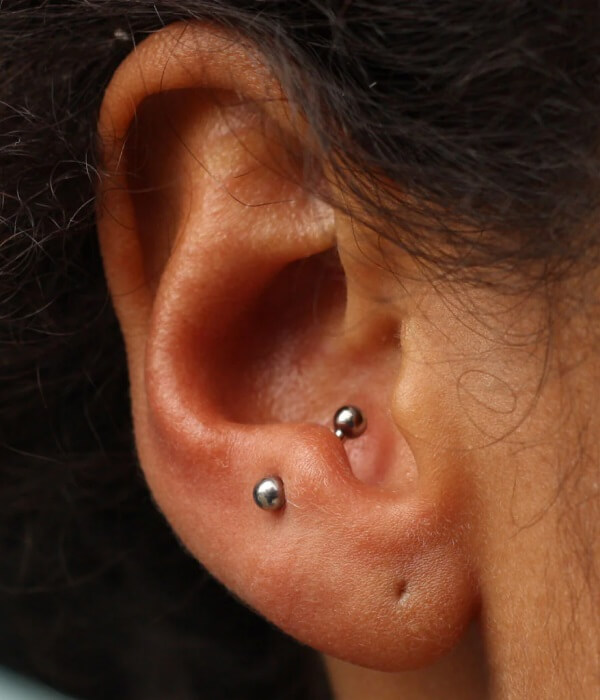
It is done just above the ear lobe (opposite the tragus).
7. Conch Piercing
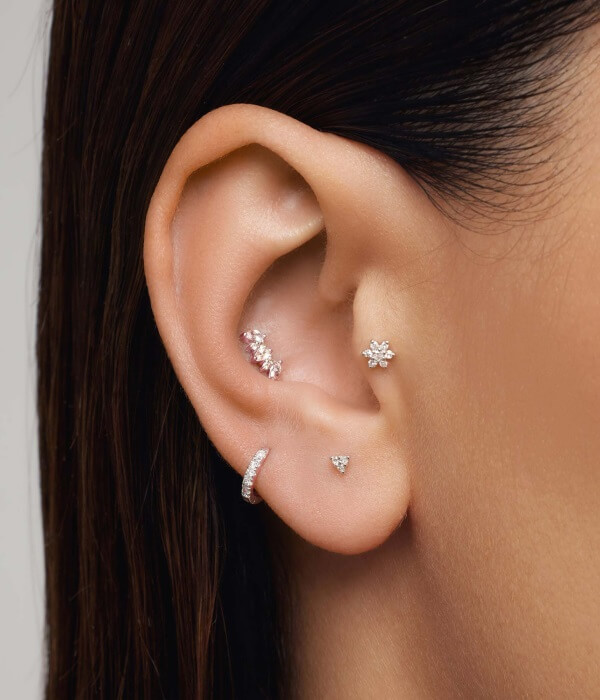
Piercing of the inner shell of the ear, also called conch is known as conch piercing.
Aside from inner shell, you can also get your outer conch (the flat part of the outer ear) pierced.
8. Rook Piercing
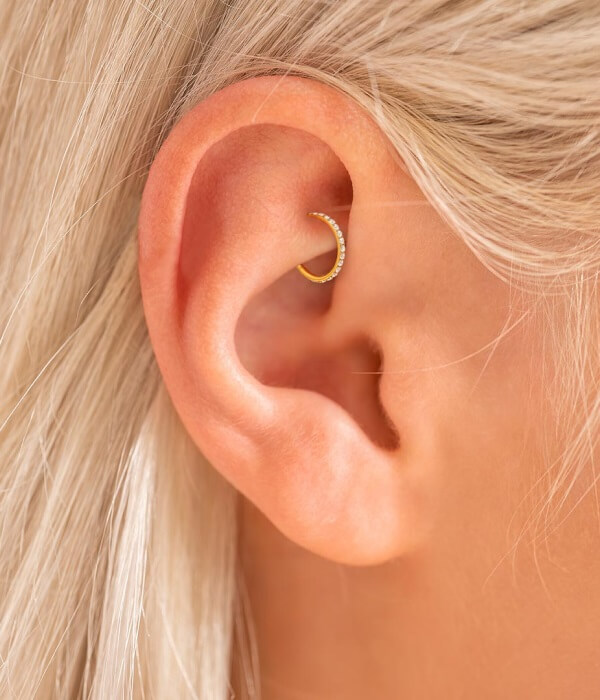
Piercing on the fold of cartilage between the inner and outer ear is known as rook piercing.
9. Snug Piercing

Snug piercing, also known as anti-helix piercing is also very common type of cartilage piercing for men.
The inner ridge of the ear running parallel to the outer rim is pierced in this kind of piercing.
10. Orbital Piercing
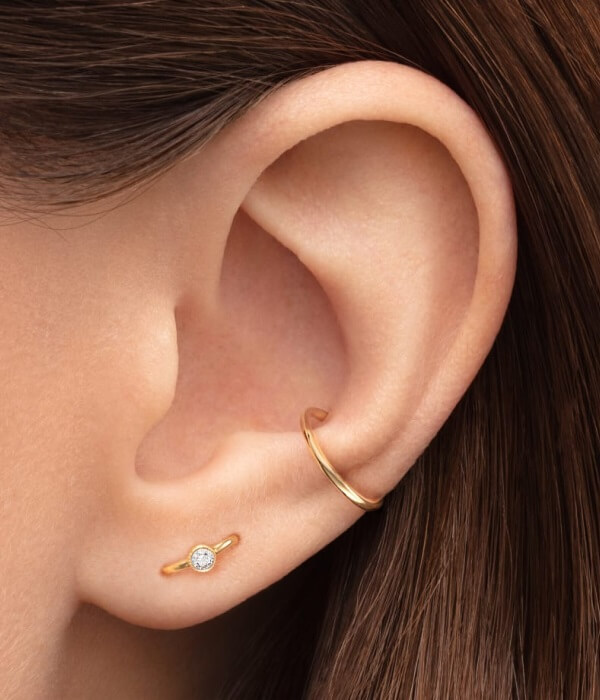
Two piercings close together connected by a single hoop is called orbital piercing.
This type of cartilage piercing can be placed on the conch, lobe, or the helix.
In-Depth Understanding of Cartilage Piercing
Cost of Cartilage Piercing
The cost of a cartilage piercing varies greatly based on several factors, including the location, the location and the reputation of the piercing studio, the experience of the piercer, the quality of jewellery used for the piercing, and so on.
On average, a cartilage piercing may cost you somewhere between $35 to $55.
Pain Level
Cartilage piercings is one of the most painful types of piercings. These piercings can vary in pain levels.
The pain level, however, depends on the part of the ear you’re getting piercing done, such as the inner shell, conch, or inner ridge.
Among all kinds of cartilage piercing man, rook piercing can be more painful.
Healing Time
Cartilage piercings vary in healing times. It typically takes somewhere between 3 to 12 months for a cartilage piercing to heal.
Majorly the healing depends on the location of the piercing. Every location presents a distinct aesthetic and differs in recovery duration.
Impact of Cartilage Piercings
Like in any other piercing, you need to be careful about cartilage piercing. Any piercing is a kind of wound that needs to be taken care of.
Initially, it pains to the touch. Additionally, it oozes white-yellow fluid.
Aside from that, you may also notice some bruising, bleeding, or redness around the newly pierced region of the body.
These are normal. However, with proper care, these symptoms subside naturally as your piercing heals.
All you have to make sure of is to get your piercing done by a reputable piercer.
Ensure they maintain the highest standards of hygiene and safety and use clean tools to prevent any risk of infection.
If you notice any symptoms for longer duration, then it is advised to visit a reputable healthcare provider for prompt intervention.
What is Cartilage Piercing Bump?
Cartilage piercing bumps are the keloids that you may develop in the area where the piercing is placed.
A keloid is a kind of raised scar tissue that appears like a bump around the pierced region.
Cartilage piercing bumps may occur due to infection. Aside from that, inflammation, scarring, etc., can also cause piercing bumps.
They are not harmful, but they certainly aren’t good either. It is advised to keep the newly pierced region clean.
In addition, applying a warm compress and chamomile compress can help treat keloids.
Things To Consider Before Getting Cartilage Piercing
Undoubtedly, cartilage piercing for men can help them have a stylish look.
But there are certain things that they need to keep in mind in order to have the best outcomes.
Here are the things that you need to keep in mind when getting piercing:
- Get it from a trained and experienced piercer: Getting your piercing from a professional piercer is crucial. They utilize sanitized tools to place the pierce. This ensures your safety and minimizes risks associated with piercing.
- Look for a state license or certification: Make sure the piercer or piercing parlour possesses all the necessary licenses and certifications. This ensures safety.
- Highest safety standards: Your piercer must maintain clean and hygienic environment. Also, it is crucial to ensure that the piercer uses sterile tools to do your piercing, wear a pair of fresh disposable gloves for the new piercing, and follow safety standards.
- Safe piercing methods: See whether or not your piercer uses safe piercing methods. Unsafe methods can be hazardous and lead to severe issues. If your piercer does not use safe methods, it’s wise to look for the one who uses the safest piercing methods and cares for your overall well-being.
- Invest in high quality cartilage piercing jewellery: You may come across numerous kinds of cartilage piercing jewellery; however, it is crucial to invest in one that is made of high-quality material, such as gold or silver. Quality jewellery not only guarantees safety but also reduces the risk of infection.
Cartilage Piercing Care
Like any other piercing, a cartilage piercing should also be kept clean at all times; otherwise, it can cause health problems.
Additionally, proper care of a cartilage piercing helps heal the wound faster.
Your piercer will provide you with a proper aftercare regime.
Make sure to follow his guidance religiously to have your piercing healed as properly as possible.
Here are some things that you can do to keep your piercing clean:
- Wash your hands before applying any solution or ointment: Cleaning your piercing is an important step. Hence, it is crucial you clean your hands first before you start cleaning your piercing.
- Clean the pierced area with antibacterial cleansing saline solution: Saline solution properly flushes out your cartilage piercing. In addition, it removes any discharge, and help to keep the wound clean. There are numerous over the counter antibacterial cleansing saline solution available out there. You may buy a good quality solution or ask your piercer for the best one.
- Use paper towel: Use only paper towels or tissues to dry the area. Avoid using cloth to dry the area as it may cause infection because of the germs present in the cloth.
- Use only chemical-free and fragrance-free solutions: Make sure to buy only chemical-free and fragrance-free saline solutions as chemicals can lead to severe concerns.
- Invest in high-quality jewellery: Invest in high-quality cartilage piercing jewellery. Also thoroughly clean your jewellery before you wear it.
- Avoid touching your wound: As we said, new piercings are like wounds. Hence, it is crucial to avoid touching your wound to keep infection at bay.
- Avoid water sports and long baths: Make sure to avoid water sports, including swimming. Also, avoid tub baths, bathing in pool, hot tubs, etc. Doing so will minimize your chances of catching infection.
- Avoid lying or sleeping on your cartilage piercing: Sleeping on cartilage piercing can hamper the healing process. Hence, it is crucial that you avoid lying or sleeping on your piercing. Also, it is crucial to use clean bedcovers and pillow covers for sleeping to prevent infection.
Cartilage Piercing Jewellery
The choice of cartilage piercing jewellery depends on the type of cartilage piercing.
Usually, labret earrings are considered best while your cartilage piercing is healing.
Also, it is recommended to avoid changing your jewellery until your wound is healed completely.
Once your piercing is properly healed, you are free to wear any kind of earrings that you would love to wear.
There are limitless jewellery options available for cartilage piercing; however, the best ones are as follows:
- Hoops, studs, or flat-back earrings are considered best for helix piercing.
- Small studs, flat-back earrings, or hoops are ideal for forward helix piercing.
- Long, straight barbells or decorative bars are considered best for industrial piercing.
- Most men prefer small hoops, clickers, and captive bead rings for daith piercing and tragus piercing.
- Studs or small hoops are ideal for anti-tragus piercing.
- Studs or larger hoops that wrap around the ear’s edge look amazing with conch piercing.
- Small curved barbells or hoops are good for rook piercing.
- You can consider opting for curved barbells or small hoops for your snug piercing.
- Hoops or rings are great options for orbital piercing.
Putting it all together…
So, this is all about cartilage piercing. We believe this guide will be useful for you and help you choose the right type of cartilage piercing.
Body piercing is a great option if you want to enhance your looks.
However, it is crucial to select a reputable piercing studio for cartilage piercing for men.
Expert piercers ensure the best piercing experience while minimizing any risk of infection or any other issue.
Thanks for reading!
Happy Piercing… 😊 😊

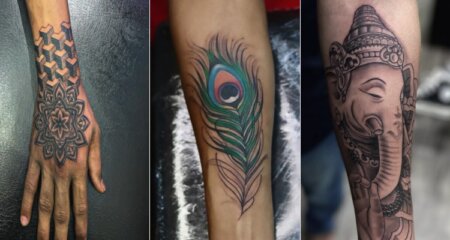

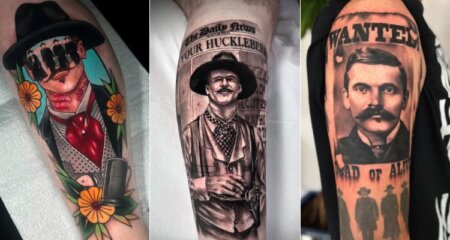
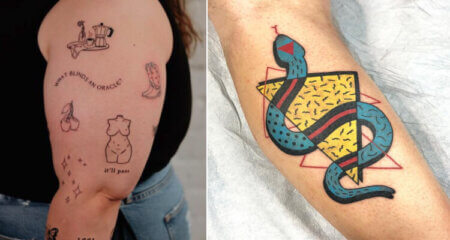
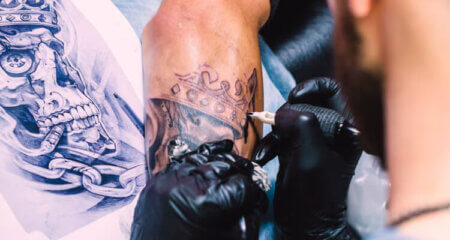
![20 Amazing Brother Sister Tattoo Ideas & Designs [2024] 20 Amazing Brother Sister Tattoo Ideas & Designs [2024]](https://www.trendingtattoo.com/wp-content/uploads/2024/08/Amazing-Brother-Sister-Tattoo-Ideas-Designs-450x240.jpg)
